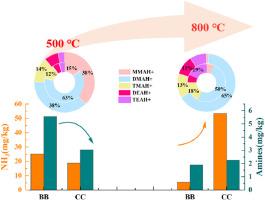Emission characteristics and formation mechanisms of ammonia and amines during residential solid fuel combustion at varying temperatures
IF 7.3
2区 环境科学与生态学
Q1 ENVIRONMENTAL SCIENCES
引用次数: 0
Abstract
Residential solid fuel combustion (RSFC) is a significant source of ammonia (NH3) and amines; however, their emission characteristics and influencing factors remain poorly understood. This study investigated the emission behavior of NH3 and C1∼C6 alkylamines from 12 fuel types categorized into three major groups (straw, firewood, and coal) via field and laboratory experiments at different temperatures. The results revealed that NH3 emissions (159.5 ± 215.6 mg/kg) were an order of magnitude higher than amine emissions (20.1 ± 23.1 mg/kg). Additionally, NH3 and amine emissions exhibited a strong synergistic relationship, with a Pearson correlation coefficient (R) of 0.5–0.8, indicating a moderate to strong positive linear correlation. Temperature and fuel types were identified as key factors influencing the emissions of NH3 and amines. Increasing the temperature from 500 to 800 °C reduced NH3 and amine emissions from biomass burning (BB) by 2–5 times but increased the emissions from low-volatility coal combustion (CC), reflecting different formation mechanisms. At low temperatures, NH3 and amines in BB are released primarily via amino acid deamination, whereas at high temperatures, they are consumed. In contrast, CC emissions are mainly driven by the high-temperature ring-opening oxidation of tightly bonded nitrogen in pyrroles and pyridines. Random forest models revealed that BB emissions are more temperature sensitive, while CC emissions are more fuel-type sensitive. High temperatures promote large-molecule amine formation in RSFC, with the proportion of diethylamine and triethylamine rising from 8.2%–11.8% at 500 °C to 18.2%–31.8% at 800 °C, and small-molecule monomethylamine rapidly decreasing to below 10%. This study indicates that synergistic control strategies based on fuel type and combustion temperature should be implemented to reduce NH3 and amine emissions.

不同温度下住宅固体燃料燃烧过程中氨和胺的排放特征及形成机理
住宅固体燃料燃烧(RSFC)是氨(NH3)和胺的重要来源;然而,它们的发射特性和影响因素仍然知之甚少。本研究通过现场和实验室实验,研究了12种燃料(秸秆、木柴和煤)在不同温度下的NH3和C1 ~ C6烷基胺的排放行为。结果表明,氨排放量(159.5±215.6 mg/kg)比胺排放量(20.1±23.1 mg/kg)高一个数量级。NH3与胺的排放表现出较强的协同关系,Pearson相关系数(R)为0.5 ~ 0.8,呈中至强的正线性相关。温度和燃料类型是影响氨和胺排放的关键因素。当温度从500℃升高到800℃时,生物质燃烧(BB)产生的NH3和胺的排放量降低了2-5倍,而低挥发性煤燃烧(CC)产生的NH3和胺的排放量增加了,这反映了不同的形成机制。在低温下,BB中的NH3和胺主要通过氨基酸脱胺释放,而在高温下,它们被消耗。相比之下,CC排放主要是由吡咯和吡啶中紧密结合的氮的高温开环氧化驱动的。随机森林模型显示,BB排放对温度更敏感,而CC排放对燃料类型更敏感。高温促进了RSFC中大分子胺的形成,二乙胺和三乙胺的比例从500℃时的8.2% ~ 11.8%上升到800℃时的18.2% ~ 31.8%,小分子一甲基胺迅速下降到10%以下。研究表明,应采取基于燃料类型和燃烧温度的协同控制策略,以减少NH3和胺的排放。
本文章由计算机程序翻译,如有差异,请以英文原文为准。
求助全文
约1分钟内获得全文
求助全文
来源期刊

Environmental Pollution
环境科学-环境科学
CiteScore
16.00
自引率
6.70%
发文量
2082
审稿时长
2.9 months
期刊介绍:
Environmental Pollution is an international peer-reviewed journal that publishes high-quality research papers and review articles covering all aspects of environmental pollution and its impacts on ecosystems and human health.
Subject areas include, but are not limited to:
• Sources and occurrences of pollutants that are clearly defined and measured in environmental compartments, food and food-related items, and human bodies;
• Interlinks between contaminant exposure and biological, ecological, and human health effects, including those of climate change;
• Contaminants of emerging concerns (including but not limited to antibiotic resistant microorganisms or genes, microplastics/nanoplastics, electronic wastes, light, and noise) and/or their biological, ecological, or human health effects;
• Laboratory and field studies on the remediation/mitigation of environmental pollution via new techniques and with clear links to biological, ecological, or human health effects;
• Modeling of pollution processes, patterns, or trends that is of clear environmental and/or human health interest;
• New techniques that measure and examine environmental occurrences, transport, behavior, and effects of pollutants within the environment or the laboratory, provided that they can be clearly used to address problems within regional or global environmental compartments.
 求助内容:
求助内容: 应助结果提醒方式:
应助结果提醒方式:


